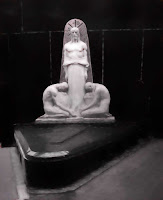Click on any image for a blow-up...
NOTE- This is NOT best viewed on a mobile phone which will delete images and text.
NOTE- This is NOT best viewed on a mobile phone which will delete images and text.
 |
| Ever wondered? Here is the middle of nowhere |
 |
| Falkland 1983 War Memorial |
 They're about 8,800 miles from Britain which has claimed ownership since the 1830s. That's when they took them from the French who previously grabbed them from the Spanish... Or maybe it was the other way around? In 1982 the Argentines invaded but were repulsed by the Brits, who it's rumored, that four years before under Maggie Thatcher they were trying to get rid of the place and its approximately 4,000 inhabitants. But those British subjects hold onto an important kernel of Parliamentary votes.
They're about 8,800 miles from Britain which has claimed ownership since the 1830s. That's when they took them from the French who previously grabbed them from the Spanish... Or maybe it was the other way around? In 1982 the Argentines invaded but were repulsed by the Brits, who it's rumored, that four years before under Maggie Thatcher they were trying to get rid of the place and its approximately 4,000 inhabitants. But those British subjects hold onto an important kernel of Parliamentary votes.So, with a bunch of pomp and difficulty, the English rag-tag navy managed to eek out a victory over the invaders - who will undoubtedly try again - or that's what everyone thinks and causes the British to keep some thousand troopers on the rocks, at shuddering expense.
 |
| Waterfront Row in Stanley |
It's hard to say exactly what the Island inhabitants do for a living, other than police, maintain, school, farm some sheep, and health-care one other, mostly in Stanley, the capital city. Its 2,100 people seem nice, speak English-English, watch American and British satellite TV and are totally inter-netted.
 |
| Upkeep's not a homeowner priority. |
 |
| Marmont Row for Brit pensioners |
When we were there on a mid-weekday, almost everyone, except for a dozen or so school kids on a sports' field, was inside. Perhaps that's the norm? As I said - we wondered what people did in Stanley but except for shopkeepers who were busy with a cruise ship visit, there was no one to ask
 |
| A village of hills |
 |
| St. Mary's Catholic |
 |
| The Anglican Cathedral & Wale Bones |
The British call these places, "box-churches". They're fabricated structures from the home country and were sent to each new conquest of the former empire to be assembled-by-numbers in their new possessions - bells, belfries, altars, stained windows, and pews. If you've seen one, you've seen the lot.
 |
| Custom House & ubiquitous Land Rover |
Like most socialist-ruled spots, the public buildings, roads, and infrastructure's are among the best maintained (look at the Parisian and Russian subways for example). No real difference on the Falklands. Police, public health, and municipal buildings there, like this custom's house, are among the spunkiest. Of course the Governor's mansion (Government House) seems the grandest in Stanley.
The Falklands historically were a sort of garage for repairing ships caught in the maelstrom of sailing around Cape Horn, a business which has Panama-Canaled away. Leaving little behind of historic, scenic, or recreational interest. It's not someplace where anyone intentionally goes, but instead people seem to wind up there on their way. So here's 80% of our gang of wayfarers trying to figure out if we should pay a couple of hundred bucks to take one of the multitude of Land Rovers on a three hour ride to a distant beach where some King Penguins were spotted a couple of days before. We didn't and those who did reported that IF there were Kings there - they'd swum away.
 |
| From left: Gib &; Marty Armstrong, Mary & Joe Mayberry, Howard Roath, Me, and Barbara & Frank Pinto. |


